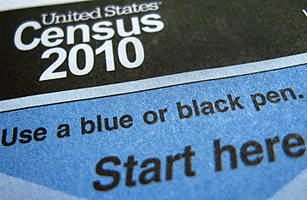
Hispanic advocates often tell the story of a Census Bureau worker who visits a Puerto Rican household in New York City’s East Harlem neighborhood. Seeing the family’s caramel complexion, the Census taker asks which race he should put down for them — white or black. To which the family answers: “Puerto Rican.”
The story could substitute a Mexican-American family — or Colombian- or Nicaraguan-American ones for that matter — but the gist would be the same. Many, if not most, Hispanics in the U.S. think of their ethnicity not just in cultural terms but in a racial context as well. It’s why more than 40% of Hispanics, when asked on the Census form in 2000 to register white or black as their race, wrote in “Other” — and they represented 95% of all the 15.3 million people in the U.S. who did so.
An even larger share of Hispanics, including my Venezuelan-American wife, is expected to report “Other,” “Hispanic” or “Latino” in the race section of the 2010 census forms being mailed to U.S. homes this month. What makes it all the more confusing if not frustrating to them is that Washington continues to insist on those forms that “Hispanic origins are not races.” If the Census Bureau lists Filipino and even Samoan as distinct races, Hispanics wonder why they — the product of half a millennium of New World miscegenation — aren’t considered a race too. “It’s a very big issue,” says Angelo Falcn, president of the National Institute for Latino Policy in New York City and a community adviser to the Census. “A lot of Hispanics find the black-white option offensive, and they’re asserting their own racial uniqueness.”
Nor are they alone. Arabs, who would seem to have an even stronger race claim than Hispanics do, are trumpeting their own write-in campaign because the Census by default counts them as white — and the bureau announced this week that it has no intention of changing that policy in 2010. Incredibly, the term Arab doesn’t even appear on the census form, though other Asian ethnicities, like Indian, are listed as races.
It’s not easy being the Census agency for America’s baroque melting pot. And to be fair, Falcn notes, the Census hasn’t slighted Hispanics in this year’s count. On the contrary, as if acknowledging that Hispanics are now the nation’s largest minority, the bureau has given the group its own “Hispanic Origins” section. It even precedes the general race section on the questionnaire and, advocates say, promises to yield a more comprehensive tally of Hispanics for purposes of federal aid and civil rights protections. But many Hispanics are nonetheless irked when they go to the next section and find, yet again, that they’re asked to identify themselves racially as white or black.
Census officials say they’re simply adhering to race-category standards laid out for all federal agencies in 1997 by the White House Office of Management and Budget, criteria they confirm will be re-evaluated before the 2020 census. And Janet Murguia, president of the National Council of La Raza, a Hispanic advocacy group in Washington, D.C., says the Hispanic race question so far “has been hard to reconcile scientifically.”
Still, Maria Teresa Kumar, executive director of Voto Latino, a Hispanic civic organization based in Washington, D.C., worries because most Hispanics who do choose between white and black select white. That “risks leaving a mistaken impression that they enjoy certain socioeconomic opportunities we associate with whites in this country,” says Kumar, “when in reality [Hispanics] are near the bottom in areas like education and upward mobility.” As a result, groups like Voto Latino are encouraging Hispanics to write Hispanic or Latino in the “Other” space for race.
While Kumar, like Falcn, applauds the Census Bureau for the 2010 form’s prominent Hispanic-origins feature, she feels the feds still fail to understand “how layered the Latino self-identity is” beyond just language. North Americans call Oct. 12 Columbus Day, but Latin Americans call it Dia de la Raza — Day of the Race — a recognition that 1492 began a commingling of primarily Iberian, native American and African blood that in turn produced a new race, sometimes called mestizo. That process was perhaps deepest in Mexico — and because Mexico is the origin country of almost two-thirds of U.S. Hispanics, that’s a big reason why Washington needs to rethink its definition of race.
Many feel the Census also needs to fine-tune its idea of what is and isn’t Hispanic. It tends to define Latin America as just the Spanish-speaking countries of the western hemisphere, when the term also encompasses Portuguese-speaking Brazil. It also includes Spaniards in the “Hispanic Origins” box, when in fact a Spaniard is a European, not a Hispanic.
All of this should prod the Census Bureau to simplify things for future counts. The Hispanic-origins and race sections should be combined into one, less confusing section that asks folks what ethnic and/or racial group they belong to: white, black, Native American, Asian, Pacific Islander or Hispanic. It should provide space for designating subgroups — like Arabs, for example. And it should make clear that respondents can check more than one group. That matters in cases like that of blacks from Hispanic countries. Those Afro-Latinos have produced a video urging each other to check the black entry and not “Other” in the race section to ensure that Washington logs that reality as well as their Hispanic status.
Accommodating, if not promoting, multiple ethnic identification seems especially important at a time when a growing number of Americans — including their President — have mixed-race parentage. For our children’s race, my wife and I simply write in Mixed for want of any better option on the census form. But in the 2020 census, we’d like them to be counted more precisely as progeny of both the Anglo race and the Latino raza.
See TIME’s Pictures of the Week.
See the Cartoons of the Week.